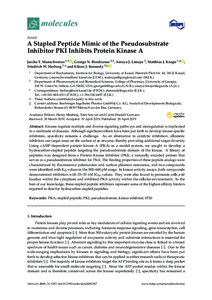Datum
2019-04-20Autor
Manschwetus, Jascha TobiasBendzunas, George N.Limaye, Ameya JitendraKnape, Matthias JosephHerberg, Friedrich W.Kennedy, Eileen J.Schlagwort
570 Biowissenschaften, BiologieMetadata
Zur Langanzeige
Aufsatz

A Stapled Peptide Mimic of the Pseudosubstrate Inhibitor PKI Inhibits Protein Kinase A
Zusammenfassung
Kinases regulate multiple and diverse signaling pathways and misregulation is implicated in a multitude of diseases. Although significant efforts have been put forth to develop kinase-specific inhibitors, specificity remains a challenge. As an alternative to catalytic inhibition, allosteric inhibitors can target areas on the surface of an enzyme, thereby providing additional target diversity. Using cAMP-dependent protein kinase A (PKA) as a model system, we sought to develop a hydrocarbon-stapled peptide targeting the pseudosubstrate domain of the kinase. A library of peptides was designed from a Protein Kinase Inhibitor (PKI), a naturally encoded protein that serves as a pseudosubstrate inhibitor for PKA. The binding properties of these peptide analogs were characterized by fluorescence polarization and surface plasmon resonance, and two compounds were identified with KD values in the 500–600 pM range. In kinase activity assays, both compounds demonstrated inhibition with 25–35 nM IC50 values. They were also found to permeate cells and localize within the cytoplasm and inhibited PKA activity within the cellular environment. To the best of our knowledge, these stapled peptide inhibitors represent some of the highest affinity binders reported to date for hydrocarbon stapled peptides.
Zitierform
In: Molecules Volume 24 / Issue 8 (2019-04-20) , S. 1567 ; ISSN 1420-3049Förderhinweis
Gefördert durch den Publikationsfonds der Universität KasselZitieren
@article{doi:10.17170/kobra-20190521523,
author={Manschwetus, Jascha Tobias and Bendzunas, George N. and Limaye, Ameya Jitendra and Knape, Matthias Joseph and Herberg, Friedrich W. and Kennedy, Eileen J.},
title={A Stapled Peptide Mimic of the Pseudosubstrate Inhibitor PKI Inhibits Protein Kinase A},
journal={Molecules},
year={2019}
}
0500 Oax 0501 Text $btxt$2rdacontent 0502 Computermedien $bc$2rdacarrier 1100 2019$n2019 1500 1/eng 2050 ##0##http://hdl.handle.net/123456789/11252 3000 Manschwetus, Jascha Tobias 3010 Bendzunas, George N. 3010 Limaye, Ameya Jitendra 3010 Knape, Matthias Joseph 3010 Herberg, Friedrich W. 3010 Kennedy, Eileen J. 4000 A Stapled Peptide Mimic of the Pseudosubstrate Inhibitor PKI Inhibits Protein Kinase A / Manschwetus, Jascha Tobias 4030 4060 Online-Ressource 4085 ##0##=u http://nbn-resolving.de/http://hdl.handle.net/123456789/11252=x R 4204 \$dAufsatz 4170 7136 ##0##http://hdl.handle.net/123456789/11252
<resource xsi:schemaLocation="http://datacite.org/schema/kernel-2.2 http://schema.datacite.org/meta/kernel-2.2/metadata.xsd"> 2019-05-22T06:27:50Z 2019-05-22T06:27:50Z 2019-04-20 doi:10.17170/kobra-20190521523 http://hdl.handle.net/123456789/11252 Gefördert durch den Publikationsfonds der Universität Kassel eng Urheberrechtlich geschützt https://rightsstatements.org/page/InC/1.0/ PKA stapled peptide PKI pseudosubstrate kinase inhibitor IP20 570 A Stapled Peptide Mimic of the Pseudosubstrate Inhibitor PKI Inhibits Protein Kinase A Aufsatz Kinases regulate multiple and diverse signaling pathways and misregulation is implicated in a multitude of diseases. Although significant efforts have been put forth to develop kinase-specific inhibitors, specificity remains a challenge. As an alternative to catalytic inhibition, allosteric inhibitors can target areas on the surface of an enzyme, thereby providing additional target diversity. Using cAMP-dependent protein kinase A (PKA) as a model system, we sought to develop a hydrocarbon-stapled peptide targeting the pseudosubstrate domain of the kinase. A library of peptides was designed from a Protein Kinase Inhibitor (PKI), a naturally encoded protein that serves as a pseudosubstrate inhibitor for PKA. The binding properties of these peptide analogs were characterized by fluorescence polarization and surface plasmon resonance, and two compounds were identified with KD values in the 500–600 pM range. In kinase activity assays, both compounds demonstrated inhibition with 25–35 nM IC50 values. They were also found to permeate cells and localize within the cytoplasm and inhibited PKA activity within the cellular environment. To the best of our knowledge, these stapled peptide inhibitors represent some of the highest affinity binders reported to date for hydrocarbon stapled peptides. open access Manschwetus, Jascha Tobias Bendzunas, George N. Limaye, Ameya Jitendra Knape, Matthias Joseph Herberg, Friedrich W. Kennedy, Eileen J. doi:10.3390/molecules24081567 publishedVersion ISSN 1420-3049 Issue 8 Molecules 1567 Volume 24 </resource>
Die folgenden Lizenzbestimmungen sind mit dieser Ressource verbunden:
Urheberrechtlich geschützt

